Chimney Cake: A Barbecued Street Food With A Transylvanian Past
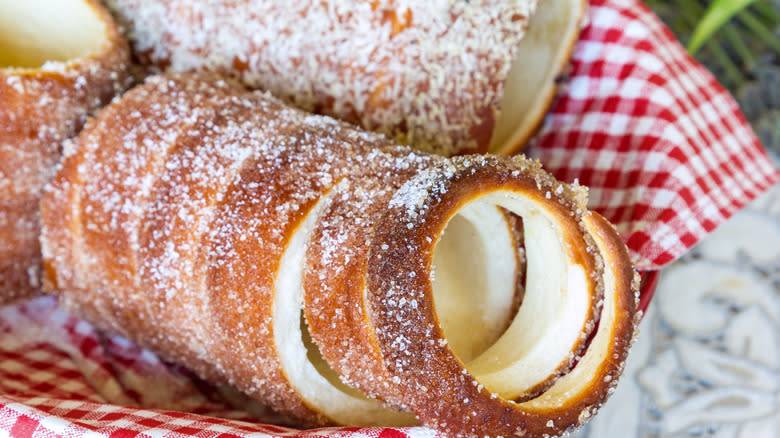
Chimney cake may not sound too appetizing, but the name doesn't refer to its being charred and soot-blackened, but rather to its tall, cylindrical shape. The chimney cake, or Kürtőskalács, is Hungary's take on the type of European pastry known as a spit cake — again with the off-putting monikers, we know. The spit, or, if you prefer, spindle, involved in the cooking is a horizontal rotisserie, and some of the more elaborate versions of these cakes include Poland's infamously difficult sękacz, Lithuania's similar sakotis, and Germany's multi-layered baumkuchen ("tree cake").
Hungary's chimney cakes originated in Transylvania — which is today part of Romania — and aren't quite as complex as some of the above cakes, as these require constant attention from a baker who ladles batter over the cakes as they rotate. Kürtőskalács, however, is made from a strip of yeast dough that is wrapped around a spindle and baked.
Read more: 12 Popular Ice Cream Brands, Ranked Worst To Best
The History Of Chimney Cake
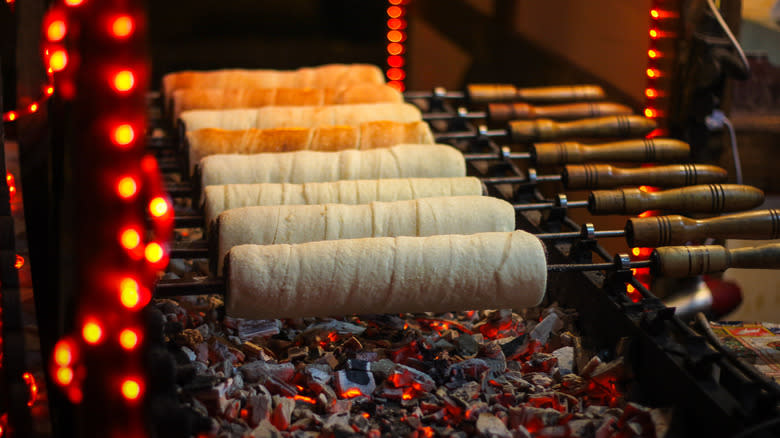
If we trace the history of chimney cake back as far as we can, the earliest known mention of such a dish is in a 15th-century German manuscript. The first recipe, however, wasn't published for another 300 years or so, as it appears in a 1784 cookbook attributed to Countess Mária Mikes of Zabola, which is located in Transylvania. At the time, the region was part of Hungary, but after some back-and-forthing subsequent to the First World War, Transylvania (including Zabola) officially became part of Romania in 1947. Despite Transylvania's 20th-century split, it seems that Hungary got custody of the chimney cake in the divorce proceedings.
The original version of kürtőskalács, or "kürtős kaláts' à la Mrs. Poráni," seems to have been a savory one because the recipe makes no mention of sugar. A different recipe that came out some 11 years later did offer the option of sweetening the cake after it was cooked, but it wasn't until the late 19th century that anyone suggested adding sugar before baking. As for the crushed nuts that are a typical kürtőskalács coating today, these date back only as far as a 1980 cookbook called "Erdélyi Lakoma" authored by Pál Kövi (later republished in 1985 as "Paul Kovi's Transylvanian Cuisine." This Hungarian-born restaurateur not only left his stamp on chimney cakes but also helmed New York's Four Seasons restaurant for over 20 years.
What Goes Into Chimney Cake
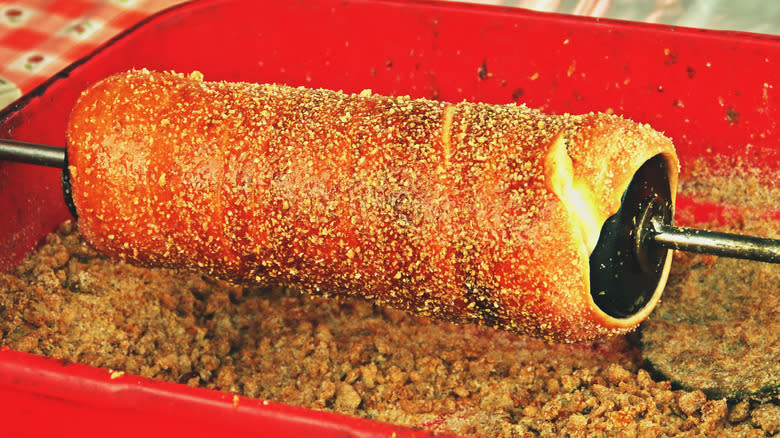
The actual chimney cake itself is nothing too fancy, at least if the ingredients are anything to go by. The dough is made from what appears to be a pretty standard array of cake ingredients. Butter, eggs, flour, milk, salt, sugar — yep, all of the usual suspects are present, although most recipes typically don't call for any spices, seasonings, or flavoring extracts like vanilla or almond. What sets the kürtőskalács dough apart from most cake batters is the inclusion of yeast, so the texture and flavor are more akin to that of sweet bread, while some people have compared it to babka.
Most of the flavor in a chimney cake comes from the coating. This may be plain sugar, which was the case with most chimney cakes baked in the 19th and early 20th centuries, although these days the sugar is often mixed with cinnamon, cocoa powder, or crushed walnuts. When the sugar melts, it provides the kürtőskalács with a caramel taste and crispy coating, while any mix-ins will, of course, lend their influence, as well.
How Chimney Cake Is Made

What makes the chimney cake so special — not to mention, gives it its name — isn't what goes into it, but how it's cooked. As the title implies, one of the methods of cooking the cake is over an open flame, although this is something you may be more likely to see at a Christmas market or other outdoor festival, and then, too, only if you should happen to be traveling in Hungary at the time. Commercial kürtőskalács bakers, though, also have the indoor option of using a special rotisserie grill that bakes multiple cakes at a time on rotating spits.
Home cooks, too, have multiple options for baking kürtőskalács. While you could use a purpose-built mold made of metal or wood, you can also DIY such an implement by wrapping foil around a rolling pin or pint-sized aluminum can. Another even simpler, option involves rolling the dough strips up into spirals without using any kind of mold at all. These cakes are then baked standing on end in a standard oven, with no need to rotate them as the upright position should ensure even cooking.
Chimney Cake Variations
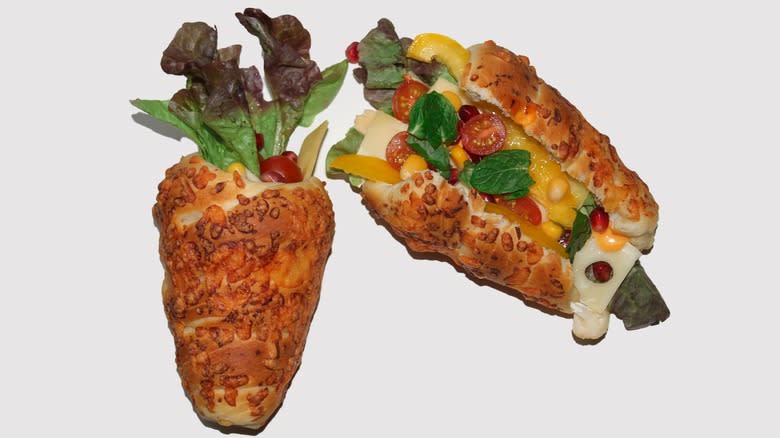
Even though using crushed walnuts as a kürtőskalács coating didn't really kick off until the 1980s, these days they are considered to be fairly traditional, along with cinnamon sugar and cocoa powder. This leaves lots of room for bakeries to experiment with other, less-traditional toppings, though, including chocolate chips, coconut, poppy seeds, pistachios, almonds, hazelnuts, and colored sprinkles. Yet another way restaurants will change up a chimney cake is by using it as an extra-tall ice cream cone or filling it with whipped cream, Nutella, or fruit.
Savory kürtőskalács is also a thing, at least in Hungary where you may be able to find them stuffed with meatballs or even the tomato-pepper stew called lecsó. Homemade chimney cakes could also be made into a main dish by omitting the sugar from the dough and filling the bread-like cones with sausage, pulled pork, shredded chicken, or chili. You could also do breakfast kürtőskalács, too. One eatery in Australia is already offering eggs Benedict in a chimney cake, while chimney cake omelets, quiches, and huevos rancheros could all be pretty tasty, as well.
Where To Try Chimney Cake
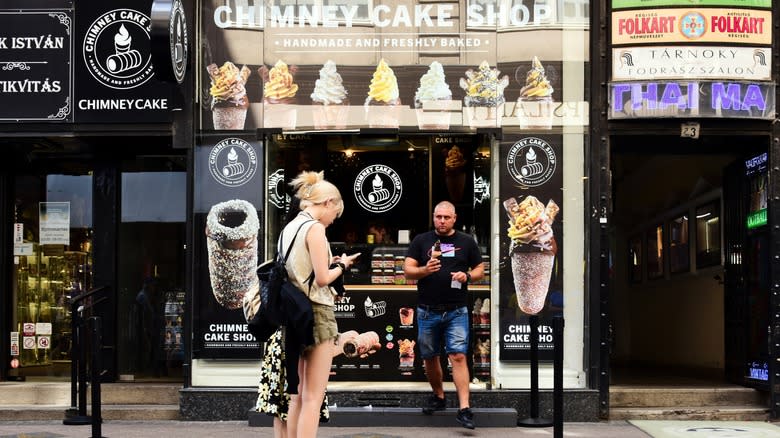
While one of the most enjoyable ways to experience kürtőskalács may be to travel to Budapest during the holiday season and buy one fresh off a street vendor's grill, Hungary's capital city also has a number of bakeries and restaurants specializing in this cake. Among these are Vitéz Kürtős, a bakery that sells not only chimney cakes but also kürtőskalács layer cakes and fondues; Kató Néni's, where some chimney cakes come in rainbow colors; and Hoppácska, where each week brings three new savory kürtőskalács that might include such options as a bacon cheeseburger served in a chimney cone.
Outside of Hungary, a mini-chain called Merika Café brings its array of chimney cakes to outposts in the United Arab Emirates, Turkey, and Australia. If you're looking to try kürtőskalács without leaving the U.S., however, you can also find them at Kürtős Cakes in Sarasota, Florida, or Chimney Cake Island in Chicago (the latter appears to be a home baker with no outlet open to the public, so you may need to order via email or Facebook and then pick the cake up at their home). It does not look as if chimney cakes can be ordered online for nationwide delivery, although Amazon sells the similar baumkuchen in a box and a non-edible but adorable kürtőskalács plushie was being offered on Etsy last we checked.
Read the original article on Mashed.

